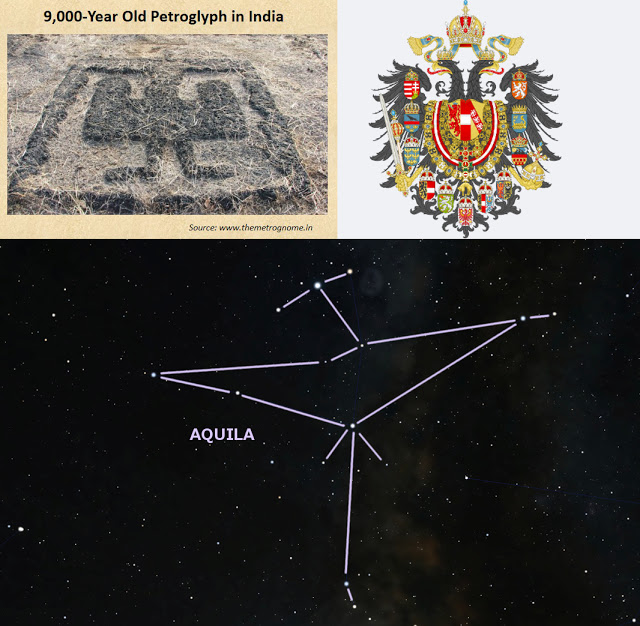image: Wikimedia commons (link).
Here is a link to another important interview with Christopher Knowles, this one from July of 2017 (scroll down to the interview date of 07/09/2017). The interview, by Dr. Bob Hieronimus on 21st Century Radio, is divided into two separate files online, each containing one hour of the interview.
Here for convenience are links to hour one and hour two of the interview. In order to download the interview to a mobile device, you can "right-click" (or "control-click") on the following two links: hour one and hour two. If you right-click (or control-click) on this second set of links, that action should bring up a pulldown menu, which contains a choice to "download linked file as" (select this option and save each file to a folder where you can find it, after which you can upload each file to iTunes, for example, and then export each one from there to a mobile device, or burn them to a pair of CDs).
In his research, Chris Knowles discovers an amazing amount of evidence which points very strongly to the conclusion that the Invisible Realm is absolutely real, despite what we have been conditioned to believe during our decades of schooling, as well as by a formidable array of reinforcing messages from various branches of the media after we complete our years of formal education.
In this interview, he lays out a very comprehensive argument regarding the reasons he believes that ancient "archetypes" (which he argues to be another name for ancient deities, who are very real) manifest themselves in modern life, despite efforts to repress or forget them.
In an extremely important display of insightful analysis, Christopher Knowles sees a connection between the use of loud music (and, at times, entheogenic plants and fungi) in the ancient mysteria and in the ecstatic music of modern rock n' roll and its many branches, permutations, and counter-reactions or counter-movements (including punk).
As he explains in this interview, and in his other work, in both cases the use of specific symbology and specific techniques (including loud music but also special effects including stage effects and lighting effects) is intended to deliberately evoke the power of the Other Realm -- and not just in a symbolic sense, but to actually achieve direct interaction with the gods.
As an example of the parallels between the ancient Mysteries and the modern music scene beginning especially in the 1960s and continuing in successive generations and permutations since then, Mr. Knowles cites the example of the Corybantes or Korybantes, who were said to bang loudly on their shields with their swords as a form of ecstatic percussion in certain ancient mysteria, and who are depicted in the famous Parabiago Plate (or Platera di Parabiago) shown above. In fact, in that ancient artwork, the Corybantes are shown accompanying the goddess Cybele, who is discussed at some length in the above-linked interview with Christopher Knowles.
Cybele, the Corybantes, and the ancient mysteria are also discussed at length in my 2014 book The Undying Stars, as well as in the later book Star Myths of the World, Volume Two(Myths of Ancient Greece).
In the above-linked interview, Christopher Knowles gives a very comprehensive look at his theory regarding what could be going on with the powerful re-emergence of these extremely ancient patterns, and at one point posits the idea that the extreme trauma of the post-WW2 decades (including the trauma created by the nuclear arms race and the pervasive sense of dread it engendered, as well as that created by the u.s. involvement in the Vietnam War during the years 1964 - 1975) may have triggered the re-emergence of these supernatural archetypes.
While I believe that is a very valid argument and a distinct possibility, I would also suggest that other forces might be at work, including deliberate, intentional, and fairly well-informed steps to evoke these kinds of supernatural forces by certain elements within the music and film industries beginning in the 1950s and continuing from there. These possible explanations are not mutually exclusive, and I would venture to guess that Mr. Knowles would also agree that multiple possible explanations could be at work in this case.
Whatever the explanation, the evidence and analysis which Christopher Knowles is writing about in his blog and in his books, and discussing in his various interviews, is extremely compelling, extremely important, and must not be overlooked by those trying to determine "what's going down" in the modern world and particularly in the trajectory of the past five or six decades.
This previous post links to two other important interviews featuring Chris Knowles and his work, and contains some additional discussion.
I believe that this topic, and the specific evidence that Mr. Knowles discusses in his research, relates directly to the practice of invoking the gods or taking on the identity of specific gods and goddesses through costume and drama, which appears to be found in cultures literally around the globe, from ancient Greece and ancient India to the Americas and China (and many others as well), discussed in this previous post entitled "Sacred ritual drama and the realm of the gods."
Note that in all of those cultures, the act of evoking the gods appears to involve loud music, driving percussive instruments, and ritual dance.
I would also add that, as the work of Mr. Knowles makes abundantly clear, the power of the gods and of the divine realm is not to be taken lightly or approached casually at all. The link in the paragraph above regarding sacred ritual drama and the realm of the gods discusses the very serious traditions observed by players in Cantonese opera down through the centuries, which they were very careful not to violate.
There is also the question of the ultimate purpose of this potential connection with the divine realm, which is examined in many different ancient myths which all follow a roughly similar pattern, in which a mortal is asked to choose a gift from a god or goddess. In the Old Testament book of I Kings, the figure of Solomon is given just such a choice -- and the text tells us that he asked for wisdom in order to help others and to promote justice, a choice which pleased the Almighty.
The ancient text tells us that the Lord specifically states that he is pleased that Solomon did not ask for riches, or long life, or power over his enemies, or even the destruction of the lives of his enemies -- thus telling us, according to the record of the of the world's ancient wisdom, the proper purpose of contact with the Infinite Realm. Other myths from other cultures which follow the same pattern demonstrate the negative consequences of making the wrong choice -- such as the story of the Judgment of Paris, who asks for the most beautiful woman in the world (thus launching the Trojan War), or the story of the choice of King Midas, who asks for wealth and riches (and learns, to his dismay, that the ability to turn everything to gold is actually a curse and not a blessing).
The work of Christopher Knowles points very strongly to the possibility that certain groups have preserved the knowledge and ability of making contact with the realm of the gods -- and they may not be motivated by the desire to gain greater wisdom in order to help the people and to prevent injustice, as advocated in the record of the world's ancient wisdom.
I would strongly recommend supporting and following his work, as a source of very important information and analysis regarding the events we see taking place around the world (and indeed in our very own country and very own neighborhood, as well as in the events which have shaped the world during the past several decades).
When we realize that the gods are real, and that they do indeed manifest in some way in individual men and women, it should help us become more serious about blessing and not cursing (which is something urged in the ancient texts and traditions of many, many cultures around the globe), and about uplifting others rather than putting them down (and working to not put ourselves down, at the same time).
And, one other important and very hopeful ramification of this information is the realization that although the power of this knowledge can be (and has been -- and continues to be) used by some for their own self-promotion, power, and enrichment, the ancient myths and scriptures are quite clear that the power of the gods stands ready to help in the fight against oppression and injustice. This is the message delivered by the god Thor himself, in the poignant story of Thor's visit to King Olaf Tryggvason of Norway. It is also seen in the assistance given by the goddess Athena to Odysseus and his family in the Odyssey of ancient Greece, as she (along with other gods, including Hermes) helps him to return home and to deal with the usurping suitors who are destroying his household and plotting to marry Penelope and murder Telemachus.
The same message is found in many other myths and sacred stories from around the globe.
---------------------
For the previous post entitled "The gods are real," follow this link.

























